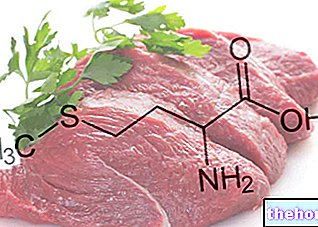
About PRO CCK - Net Supplements - Pinnothin
PRO CCK - Net supplements
Food supplement based on CLA and Korean pine.
FORMAT
Pack of 90 capsules
COMPOSITION
Concentrate of conjugated linoleic acid (clarinol); Korean pine; Jelly
Per serving (2 capsules): CLA 720mg; Korean pine 720 mg
Pinnothin: is a product of vegetable origin, obtained from Korean pine seed oil, characterized by the presence of polyunsaturated and monounsaturated fatty acids, which amount to about 92% of the total. Among these fatty acids there is one characteristic, polyunsaturated at 18 carbon atoms known as pinolenic acid, responsible for the biological effects of this supplement. Experimental evidence shows how pinolenic acid can:
- Increase the secretion of cholecystokinin (CCK) in cell cultures. Cholecystokinin is a hormone released at the duodaneal level following a meal rich in proteins and lipids, necessary to ensure the release of bile and pancreatic digestive enzymes; very importantly, cholecystokinin allows to delay gastric emptying and promote the sense of satiety.
- Reduce the food intake (amount of food ingested) by 9% in 42 overweight patients: leading to a significant calorie saving which affects a faster weight loss process.

Conjugated Linoleic Acid (CLA) - Conjugated linoleic acid is an essential fatty acid, consisting of 18 carbon atoms and 2 double bonds, organized in various isomeric forms. Among all the possible isomers, the most biologically active and most naturally occurring are cis9 - trans 11 and trans 10 - cis12, which appear to be responsible for the benefits of supplementation with CLA.
As an essential fatty acid, conjugated linoleic acid must necessarily be introduced through the diet and in particular through milk and derivatives, ruminant meat and some vegetable oils such as sunflower and safflower. Its intake is particularly important, as it influences some fundamental physiological and biochemical properties. In fact, it falls within:
- modulation of the immune response: enhancing specific and adaptive immunity and reducing hypersensitivity;
- Antithrombotic action: reducing plasma cholesterol levels and pro-thrombotic and pro-inflammatory factors;
- Anti-carcinogenic action: reducing neoplastic proliferation, in vitro and in animal models, by intervening on the cell cycle and inducing apoptosis.

- Inhibition of lipogenesis, mediated by the reduction of lipoproteinlipase activity.
- Thermogenic effect, induced by the increased expression of uncoupling proteins, which allow a large part of the energy to be dissipated in the form of heat;
- Induction of the beta oxidation process, guaranteed by the activation of carnitine acetyl transferase;
- Induction of apoptosis of pre-adipocytes.
Product Features PRO CCK - Net Supplements - Pinnothin
The product in question was evidently born as an adjuvant in slimming processes. The synergistic action of pinnothin and CLA, in fact, should on the one hand reduce food uptake, guaranteeing significant caloric savings, and on the other improve body composition, facilitating the slimming process. Despite this synergy is potentially and theoretically motivated , there is a lack of experimental evidence to confirm its efficacy.
Rationale - PRO CCK - Net supplements - Pinnothin
As for pinnothin, the literature is still very scarce, characterized by a single clinical trial that confirms the validity of this polyunsaturated fatty acid in reducing appetite and controlling CCK secretion.
As regards CLA, however, it is possible to count more than 1000 studies on it, most of them in discordance with each other; for this reason, the various researches do not allow definitive conclusions to be drawn on the matter.
The presence of potential medium-term side effects and particularly important experimental evidence only on animal models, the absence of significant advantages on humans, the partial understanding of molecular mechanisms and the presence of isomers with opposite functionalities, definitely limits its use. of this product in supplementary practice.
How to use recommended by the company - PRO CCK - Net supplements - Pinnothin
It is recommended to take 2 capsules a day with water or other liquids of your choice, preferably 1 hour before lunch.
Method of use in sports - PRO CCK - Net supplements - Pinnothin
As for pinnothin, the only noteworthy clinical trial involves administering 2 grams about 30 minutes before lunch; according to the study, this dose guarantees a 9% reduction in food intake.
In the case of CLA, on the other hand, very different dosages are used, albeit between 2 grams and 6 grams per day. The most represented dosage seems to be that of 3.4 g / day, divided into different intakes adjacent to meals.
Supplementation, which should be prolonged for several weeks, must necessarily be evaluated by your doctor.
Synergies PRO CCK - Net supplements - Pinnothin
DIET PLAN AND PHYSICAL ACTIVITY: in order for CLA to assist in weight loss, it is NECESSARY to program a controlled, healthy and possibly low-calorie diet, associated with a planned physical activity adapted to individual needs.
Also in this case it is possible to describe some studies conducted on animals that associate CLA with arginine, recording positive effects on the increase of lean mass, but which make little sense, given the absence of the equivalent in humans.
PRO CCK Side Effects - Net Supplements - Pinnothin
Despite the absence of serious side effects recorded following the assumption of CLA, there are various reports on possible worsening effects in various pathological conditions:
- Increase of inflammatory biomarkers (c-reactive protein and white blood cells): despite these evidences, CLA has been shown to be particularly useful precisely for its anti-inflammatory properties.
- Increased Insulin Resistance: This effect, which appears to be more pronounced for the T10, C12 isomer, drops significantly when using an equally composed mixture.
- Increased oxidative stress: increase in lipoperoxidation levels.
- Dyslipidemic effect: associated with the T10 isomer, C12 results in a reduction in plasma HDL cholesterol levels, with an increase in LDL cholesterol.
Pinoleic acid: the administration of this fatty acid seems to be well tolerated in humans and laboratory animals, so much so that even at doses of 10.242 mg / kg / day continued for several weeks, it does not seem to be related to any side effect.
However, there is a lack of studies evaluating its long-term safety.
Precautions for using PRO CCK - Net supplements - Pinnothin
The product is contraindicated in cases of renal or hepatic pathology, cardiovascular disease and / or hypertension, during pregnancy, during lactation and under the age of 14. In case of prolonged use (over 6/8 weeks), the opinion is required. of the doctor.
This article, elaborated on the critical rereading of scientific articles, university texts and common practice, is for information purposes only and therefore has no medical prescription value. It is therefore always required to consult your doctor, nutritionist or pharmacist before undertaking the use of any supplement.. Learn more about the critical analysis of PRO CCK - Net Supplements - Pinnothin.
Regul Toxicol Pharmacol. 2009 Nov; 55: 158-65. Epub 2009 Jun 25.
A sub-chronic (13 weeks) oral toxicity study in rats and an in vitro genotoxicity study with Korean pine nut oil (PinnoThin TG).Speijers GJ, Dederen LH, Keizer H.
General Health Effects, Toxicology and Safety of Food (GETS), Nieuwegein, The Netherlands.
Lipids Health Dis. 2008 Feb 28; 7: 6.
Hughes GM, Boyland EJ, Williams NJ, Mennen L, Scott C, Kirkham TC, Harrold JA, Keizer HG, Halford JC.
Conjugated linoleic acid combined with creatine monohydrate and whey protein supplementation during strength training.
Cornish SM, Candow DG, Jantz NT, Chilibeck PD, Little JP, Forbes S, Abeysekara S, Zello GA.
Int J Sport Nutr Exerc Metab. 2009 Feb; 19: 79-96.
Creatine monohydrate and conjugated linoleic acid improve strength and body composition following resistance exercise in older adults.
Tarnopolsky M, Zimmer A, Paikin J, Safdar A, Aboud A, Pearce E, Roy B, Doherty T.
PLoS One. 2007 Oct 3; 2: e991.
. Nov; 44: 975-82. Epub 2009 Sep 25.
Conjugated linoleic acid induces uncoupling protein 1 in white adipose tissue of ob / ob mice.
Wendel AA, Purushotham A, Liu LF, Belury MA.
Nutr Rev. 2008 Jul; 66: 415-21.
Plourde M, Jew S, Cunnane SC, Jones PJ.
Eur J Clin Nutr. 2003 Oct; 57: 1268-74.
Kamphuis MM, Lejeune MP, Saris WH, Westerterp-Plantenga MS.
J Food Sci. 2007 Oct; 72: S612-7.
Park Y, Albright KJ, Storkson JM, Liu W, Pariza MW.
J Nutr Biochem. 2008 Jan; 19: 61-8. Epub 2007 May 24.
Diaz ML, Watkins BA, Li Y, Anderson RA, Campbell WW.
No synergistic effect
Am J Clin Nutr. 2007 May; 85: 1203-11.
Whigham LD, Watras AC, Schoeller DA.
J Nutr. 2005 Apr; 135: 778-84.
Supplementation with conjugated linoleic acid for 24 months is well tolerated by and reduces body fat mass in healthy, overweight humans.Gaullier JM, Halse J, Høye K, Kristiansen K, Fagertun H, Vik H, Gudmundsen O.
Lipids. 2009 Nov; 44: 983-8. Epub 2009 Oct 23.
Conjugated linoleic acid isomers, t10c12 and c9t11, are differentially incorporated into adipose tissue and skeletal muscle in humans.Goedecke JH, Rae DE, Smuts CM, Lambert EV, O "Shea M.
J Nutr. 2009 Jul; 139: 1279-85. Epub 2009 May 13.
Nall JL, Wu G, Kim KH, Choi CW, Smith SB.
Int J Obes (Lond). 2007 Mar; 31: 481-7. Epub 2006 Aug 22.
The role of conjugated linoleic acid in reducing body fat and preventing holiday weight gain.Watras AC, Buchholz AC, Close RN, Zhang Z, Schoeller DA.
Riserus U, Arner P, Brismar K, Vessby B. Treatment with dietary trans10cis12 conjugated linoleic acid causes isomer-specific insulin resistance in obese men with the metabolic syndrome.
Diabetes Care 2002; 25: 1516-21
Int J Obes Relat Metab Disord. 2003 Jul; 27: 840-7.
The effect of conjugated linoleic acid supplementation after weight loss on body weight regain, body composition, and resting metabolic rate in overweight subjects.Kamphuis MM, Lejeune MP, Saris WH, Westerterp-Plantenga MS.
Eur J Clin Nutr. 2005 Apr; 59: 508-17.
Song HJ, Grant I, Rotondo D, Mohede I, Sattar N, Heys SD, Wahle KW.
J Nutr. 2007 Dec; 137: 2599-607.
Kelley NS, Hubbard NE, Erickson KL.









.jpg)


















